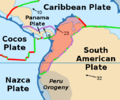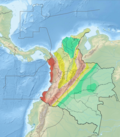Geological setting
The Panama plate is a south-western extension of the Caribbean plate surrounded by five tectonic plates: the South American plate, Caribbean plate, Cocos plate, and Nazca plate, and by the Chortis tectonic block. [2] The plate had once been a piece of volcanic arc that split off from the rest of the Caribbean plate between the late Tertiary and early Quaternary and is currently moving in a northward direction. [3]
The Panama microplate is bordered to the north by the Panama deformed belt and a diffuse thrust belt in the Cordillera Central of Costa Rica. These thrust belts are being controlled by the active convergence of the Caribbean plate towards Central America. The eastern edge of the Panama plate is progressively conjoining with the continental plate of South America. Its western end is in contact with the continental Chortis block lying along a late cretaceous convergence zone where the Mesquito composite oceanic terrane is exposed. The plate's southern boundary is a subduction zone composed of the downward moving Cocos and Nazca plates. [2]
The western expanse of the Panama microplate is characterized by deformation originating from the Tertiary and Quaternary, linking the North Panama deformed belt in the east with the Middle America trench in the west. Major changes in tectonic evolution exist across the Caribbean-Panama boundary, where three northeast-striking faults intersect with the Pacific coast. [4] The Pacific side of the region is geologically active, with a narrow marine shelf exhibiting frequent volcanic activity and higher seismic activity, and the Atlantic side is more stable with a passive margin and broader marine shelf. [5]
This page is based on this
Wikipedia article Text is available under the
CC BY-SA 4.0 license; additional terms may apply.
Images, videos and audio are available under their respective licenses.




